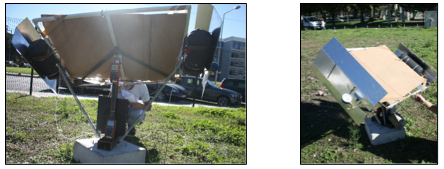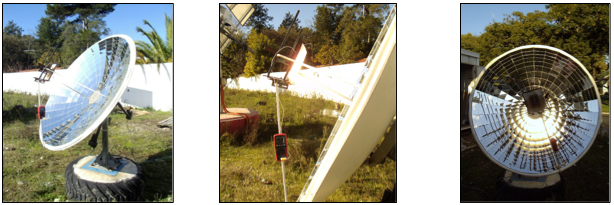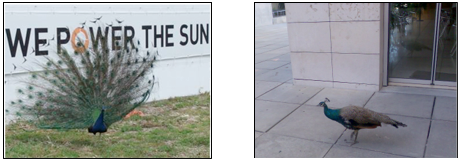Passive solar tracking

Prototype built by students Afonso Cardoso, Noa Estes, João Jorge and António Relógio, from Energy and Environmental Engineering. It consists of a passive solar tracking system with the objective of increasing the solar exposure of solar panels in a simple and low-cost way. Without motors and without being connected to electricity, the tracker follows the sun's apparent movement throughout the day, allowing for an increase of up to 25% in the solar radiation reaching the panels.
The accelerated video of the follower's movement over the course of a day shows that at daybreak the panel will be facing west, requiring some time to redirect to the east - the shorter the orientation time to the east, the greater the capture efficiency of radiation at this time of day.
Mirrored dish

Project of a parabolic solar concentrator completed in 3 parts. Started by students Ricardo Jónatas and Ricardo Pratas from Project in Energy and Environmental Engineering, who in 2009/2010 built the concentrator plate, it was again approached by students Bruno Oliveira and Filipe Nunes who developed the tracking algorithm and the structure of support in the year 2010/2011. Finally, in 2011/2012, students Henrique Garrido, Pedro Rosa and André Sousa gave life to the system through the inclusion of monitoring engines and the interconnection of the systems and their respective interfaces. The tests carried out showed that on the plate that marks the focus, temperatures above 500°C are reached and the efficiency of the system depends a lot on the mirror cleaning conditions.
Radon Measurement

It is a station for continuous monitoring of gamma radiation from the ground, in order to allow the study of the variability of radon gas concentration in relation to various meteorological parameters (such as temperature, precipitation, solar radiation, wind, pressure, humidity ) and other gases present in the atmosphere such as CO2. It consists of placing a tube vertically on the ground at both ends, in order to prevent the entry of moisture into its interior, as well as two thermocouples and an iButton sensor for recording the temperature and humidity, respectively, in the datalogger installed in an airtight case next to the tube.
Others

In addition to learning about our scientific projects, you can get to know the beautiful peacocks that roam freely around the campus!

